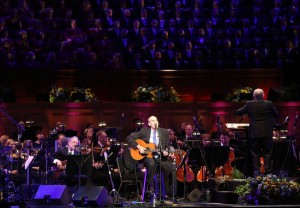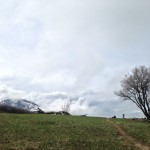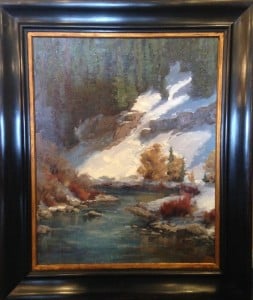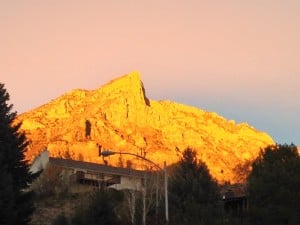
Last night I had the unusual opportunity to hear James Taylor sing with the Mormon Tabernacle Choir. I have seen JT in concert many times. If I remember correctly, that was my fifth. And I have seen the choir perform many times too, of course. I love choral music, especially sacred music, but I also love the gritty voice of a balladeer, someone who sings from the rooted individual experiences of loss, error, political and social disappointment, and personal redemption. My love for both kinds of music was cultivated simultaneously as I was growing up. I sang in my High School choir and in an acappella group and I went to every concert I could get to of the likes of JT, CSN, Neil Young, Billy Joel, and others.
This concert was the fruit of a friendship between Obert C. Tanner and Gordon B. Hinckley. Tanner was a successful businessman, philanthropist, philosopher, and lover of the arts and someone who had moved away from his Mormon roots. Hinckley was the president and prophet of the Mormon church at the end of his life after decades of service as a church leader. The two were friends, and this concert, now in its thirtieth year, is a gift to the community, entirely free, and a proud symbol of our community. Two nights with JT, with over 22,000 people in attendance each night.
The great Mexican poet, Octavio Paz, lived in a divided society, divided by class, ethnicity, and historical consciousness. And he felt that the most powerful form of communal healing for his country was ritual and the performance of art—the staging and reception of theatrical works, the reading of poetry, musical performances, the participation in festival and commemoration, and public acts of storytelling and myth-making. He believed that these public forms of embracing the various strands of culture into one whole were vital to a culture’s chance of survival. Otherwise history, philosophy, worldview, ethnicity, and class would perpetually divide his country against itself. Art was the means by which the “nightmare” of experience could be transformed into what he called “vision.” Just as a metaphor brings together two unlike things into a meaningful relationship without collapsing their crucial differences, so too does art imagine a wholeness out of fragmented and even oppositional differences while still respecting the reality of those differences. This is what he calls communion, when opposites agree. C.S. Lewis noted similarly that literature “heals the wound without undermining the privilege of individuality.” We transcend ourselves in art but we are, as he puts it, never more ourselves than when we do. Art, he insisted, wasn’t the only way to achieve this, however; the experience of creating and enjoying art has the same benefits of service, worship, collaboration, and all other meaningful expressions of love.
Both Paz and Lewis felt that art’s role was to combat the great many forces in society that offer false alternatives to such meaningful experiences of community. In a world of ever-increasing crass commercialization, we are offered at every turn the chance to relieve ourselves of the burdens of being individuals. This world of “aesthetic impoverishment,” as Paz sees it, tends toward generating a more superficial and quantitative sameness by which a sense of unity with others is achieved at the cost of shunning or repressing our important differences. This covert violence is the result of what Lewis calls “mass emotions” that offer a balm for the wound of being solitary individuals but then essentially obliterate the very differences that form the basis of our awareness of being unique.
Of course, there is a fine line between mass emotions and true aesthetic awareness, but the proof is in the results: do we get lost in a crowd or do we discover ourselves as one among many and even united in our differences? There is no pure space—not in any concert hall, museum, church, or in the walls of academia—where art can be perfectly protected from or prove reliably invulnerable to the temptations of false community, the influence of crass commercialism, or the allure of easy sameness. Careful and repeated cultivation of aesthetic experience can, however, go a long way to help us to recognize and perhaps ultimately resist the cheapness of commercial offerings.
Last night’s performance was the result of an ethical obligation rather than pure commercial interest. The rehearsals, the time and energy, and all the talent that were poured into the evening’s performance were motivated by a desire to honor the friendship and vision of O.C. Tanner and Gordon B. Hinckley. And it was not a natural or easy fit to bring the music of James Taylor and the music of the symphony and choir together in one night. For me, it was as if my worlds were colliding as I heard Elder Henry B. Eyring, a beloved LDS leader, introduce James Taylor, as I listened to a prayer offered on his behalf by the former director of the Mormon Tabernacle Choir thanking God for his gifts, and as I listened to his soothing baritone voice singing about the virtues of enjoying the passage of time and of showering the people we love with love. I watched him jump up and down with his guitar, as I have seen him do many times before, as the song “Up on the Roof” reached its climax, even though this time he turned his back to the audience and faced a symphony orchestra, the massive choir behind them, and the gorgeous organ façade against magnificent lighting. It was a euphoric, if jarring, moment. I felt a strange commingling of past and present, of the sacred and the secular, of the personal and the communal. Just the production of the event itself surely was already a significant achievement of community, but then to share this with the public, free of charge, achieved even more.
What perhaps exemplifies this best is the experience of hearing JT sing “Lonesome Road” accompanied by 360 voices. The song was born out of private pain. It is a ballad to oneself, speaking to oneself as if from an outside perspective but very privately counseling the soul to walk the path of the consequences of one’s choices alone and to refuse the false comfort of feeling sorry for oneself. I was struck, as I listened, by the paradox that JT’s own private pain had been transformed into a healing expression of communion, sharing a melody and a harmony with the world, and that here he was, no longer alone, but instead surrounded by hundreds of voices and their voices together echoing in a hall with thousands of listeners. What a community had been born of that private anguish! Two of the listeners included one of my best friends sitting next to me whose mother passed away the day before and his father whose own lonesome road now required him to be without his companion for the first time in many decades. Perhaps it remains true, as Joseph Conrad once said, that we live as we dream—alone, but we mourn together, we hope together, we make music together, and we love in communities, not in isolation. The unique experience of shared solitude is the gift of art.
The song that worked the best musically, in my view, was “The Water is Wide,” an old English song about a struggling marriage. The song speaks of the wide space of difference that must be traversed to make marriage work and of the ways in which love “grows old and waxes cold.” Its appeal is:
Build me a boat
That can carry two
And both shall row
My love and I
To whom is this appeal to build the boat? It is ambiguous. It might be the listener, much like Prospero’s audience at the conclusion of The Tempest who must be the wind in his sails to get him home. If we have been moved by the music, then we have provided the singer the boat. So maybe the boat is the song itself, the gentle appeal of its melody, its melancholic but healing call for a means to traverse the distance that separates us from one another. One cannot listen to this song and not feel both pained at our human struggle but comforted by the beauty of music that works as compensation for our failings and a sign of our hope. And one could not hear it last night and not feel some hope for our chances at real community.











